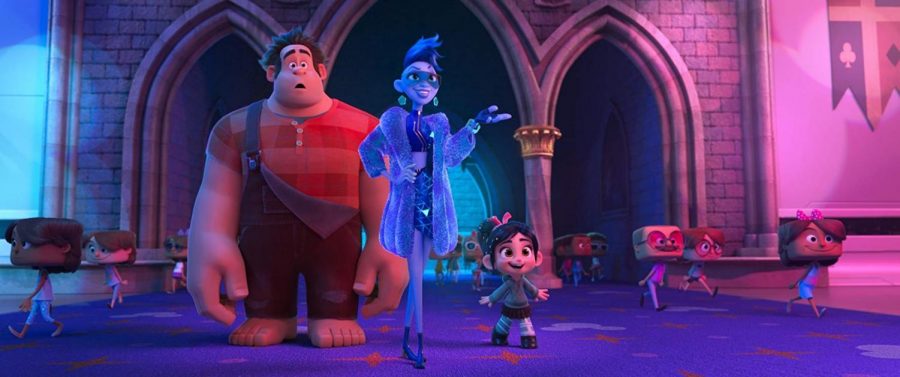The message of ‘Ralph Breaks the Internet’ clicks
“Ralph Breaks the Internet,” the long-awaited sequel to Disney’s “Wreck-It Ralph,” crashed into theatres on Nov. 21. Hype for the film built through teaser trailers, primarily featuring familiar interfaces like iPad apps, social media sites, and of course, Disney princesses.
“Ralph Breaks the Internet” stars John C. Reilly as Wreck-It Ralph, a gentle video game villain, and Sarah Silverman as Vanellope von Schweetz, a spunky princess of a racing game. In their world, arcade game characters can explore each world freely—as long as their game is plugged into a power strip. In the film, the power strip is designed like a train station with exits to each game. Beloved characters from video games such as Sonic the Hedgehog and Pac-Man make cameos, appealing to the older generation. When Vanellope’s arcade game breaks, Ralph and Vanellope venture into the Wi-Fi router to retrieve a new steering wheel for the game.
In the film, Ralph is willing to do nearly anything to help Vanellope stay in the arcade world. But when they go to different parts of the Internet, Ralph panics since they hadn’t been separated in six years. Compared to a cushy arcade, the Internet world is never-ending and—in Ralph’s perspective—dangerous. Although Vanellope reassures him that she will be fine, Ralph’s insecurity is a persistent theme throughout the film. He is not worried about threats to her safety, but threats to their friendship. As a previously estranged video game villain, he clings to Vanellope because she was the first person who appreciated him for more than his role in society. Beyond the plot, Ralph and Vanellope illustrate the expansive spectrum of healthy relationships.
Vanellope remarks that she doesn’t know who she is without her video game, which essentially provides her role in society. Ralph tries to comfort her by stating that she is his best friend, which she says “isn’t enough.” This deeply offends Ralph; however, Vanellope was merely saying that she has to be more than a game and more than a friend to someone else—instead, she is seeking a higher purpose. On the other hand, Ralph is content with his daily rotation between work and hanging out with her. He fills his life with one single person, which is not uncommon. He also becomes threatened by new friends in her life, which, again, is not uncommon, but festers into spite and anger. As Ralph takes a valid emotion and turns it into a hateful reaction, he provides a clear image of an unhealthy relationship. On the other hand, Vanellope explores a world beyond the arcade and Ralph, reassuring him that they are still friends and asserting her own independence. She provides security in their friendship while understanding that she needs to do something for herself.
Disney tackles the issues of codependence so candidly in “Ralph Breaks the Internet,” which I haven’t seen before in a film targeted to kids. “Ralph Breaks the Internet” depicts the root of unhealthy relationships: insecurity. Because both Ralph and Vanellope didn’t have a secure sense of self, they fell into a codependent relationship that is ingrained in the turns of the story. Overall, the media doesn’t do a great job of defining healthy relationships, but this film depicts the turbulence of codependence and even makes it a central plot point, which I certainly applaud. So, as always, Disney didn’t just make a “kid’s movie.” Adults and kids can enjoy the mix of meta jokes, meme references and clever humor that tethers the film and prevents the plot from becoming too campy and the messages from becoming too preachy. Above all, “Ralph Breaks the Internet” is a comedy film with emotional highlights and a valuable message about friendships.
Your donation will support the student journalists of Saint Louis University.




